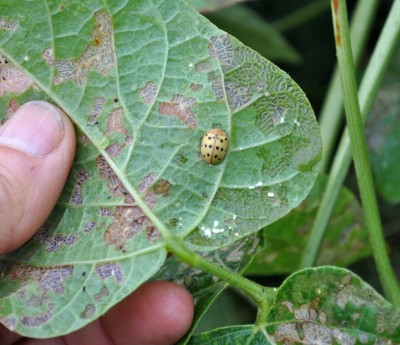[houseplant scale, bean beetles, orchid]
This year, I’m determined minimize the number of scale insects that hitchhike into my home as I bring potted citrus, gardenia, and orchid plants indoors. So beginning 3 weeks ago, every Monday I started dousing the plants with a relatively nontoxic spray, soap. (Nontoxic to just about everything except those scale insects, that is.)
Soap is a contact killer for insects, causing death by collapsing cell membranes, resulting in contents leaking out of cells and dehydration. Sounds gruesome, eh? It’s that or letting the scale insects weaken plants and drip their sticky honeydew, which they exude, on leaves, furniture, and carpet through winter. Fungi then move in to gobble up the honeydew, casting a dark shadow wherever it has dripped. Sounds worse, eh?
Scales are tough little critters protected for much of their life beneath a protective shell while they sit in place sucking the sap out of a plant. They’re most susceptible to the effects of soap before they find a place to settle down, put up their shell, and eat. That’s why I’ve sprayed every week. I want to get newly hatched ones while they are in transit looking for a new home.
Traditionally, gardeners have used various kinds of hand soaps for killing insects. Commercially available “insecticidal soaps” have a slightly different and more effective formulation. I couldn’t find my commercial insecticidal soap, so I just mixed up some liquid castille soap (similar to Dr. Bronner’s) at two and a half tablespoons per gallon and sprayed that instead. I finally found my container of commercial ‘Safer Insecticidal Soap’ this week and will use it for these last couple of sprays.
After the next spray, I’ll thoroughly drench the leaves and stems of the plants with water and then move the plants indoors. Scale insects are hard to eradicate, so I’ll keep an eye on the plants in the coming months and spritz them with more soap if needed.

*****************************************************
Mexican bean beetles are one immigrant that should have been deemed illegal and not been allowed to cross our borders. Of course, beetles are hard to stop. And they’ve been around a long time — they were in the Southwest back in 1850 — so could be considered naturalized.
This year I may have neglected this problem, which shows up every year in my garden, for too long. Or, perhaps the beetles have been more voracious than most years. Either way, leaves of my bean plants are lacy from beetle banquets.
All because of the beetles, I had to give up growing pole beans years ago. Pole beans’ long season provided too continuous a food supply for the beetles. So these days I grow bush beans, making 3 or 4 plantings at intervals through the growing season, pulling out and composting older plantings as soon as they get too many beetles on them. This year’s especially bad infestations of bean beetles also might be the result of my sowing new plantings too close to older plantings.
Beetles notwithstanding, I have not yet had my fill of beans. It’s too late for another sowing, of course, but a couple of weeks ago thought it might still be worth trying to kill the pest. Back again to that ‘Safer Insecticidal Soap.’ The soap is most effective against soft-bodied insects so should shrivel up the voracious, soft-bodied yellow larvae. Perhaps it would also kill the adult beetles.
Too late. This late in the season, there’s not enough light and some days not enough warmth to get the bean plants to sprout new leaves and beans. Into the compost pile they go — along with the beetles.
One nice thing about growing a diversity of fruits and vegetables in a home garden is that, despite bugs, drought, or other agricultural calamities, there’s always plenty of something to harvest. Even with the worst case scenario of a beetle-induced end to this year’s bush beans, my scarlet runner beans, a different species of bean and planted mostly as ornamentals, are still bearing plenty of ugly but tasty green beans.
*******************************************************
Some people are intimidated by orchids; I was once. Then, about 20 years ago, a local orchid enthusiast gave me some orchid plants, what must have been easy to grow orchids with the not so easy to

speak name of Odontoglossum pulchellum. Every winter, slender flower stalks emerge from among the fat pseudobulbs of these dainty plants, which I have multiplied over the years. Along those stems unfold elegant, small, whit
e flowers, fragrant and seemingly sculpted from porcelain. The flowers stay around to brighten up winter days for almost 2 months!
My orchids is just one of the over 25,000 species of orchids, from which there’s something for anyyone according to your floral likes and green thumb.




When I was an apprentice on New Morning Farm in south-central PA, we had great results by releasing Pediobius wasps for Mexican Bean Beetle control – I’m not sure how you’d adapt to garden-scale (or whether it would be worth the cost of the wasps), but it might be worth experimenting – I must say it was fun to “watch” the wasps’ progress by finding the little mummified beetle larvae.
Stacy
I talked to Jim Crawford of New Morning Farm this summer. His spin on this is that it works great on a commercial sale, but was too expensive for the home gardener. His neighbors did mention that they don’t seem to have any problems for the bugs Jim controls – looks like Jim is taking care of his entire neighborhood!
Gary